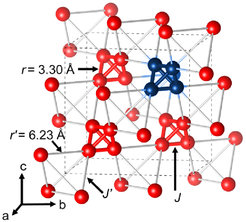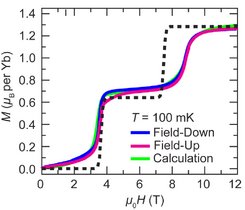Press Release: A molecular quantum magnet realized in an inorganic solid
During the past few decades, scientists all over the world have been searching for materials, which can be used to build a superior computing device than the semiconductor-based one. The corresponding research field is known as ‘quantum computing’ and as implied by the name future technology is seeking for new possibilities offered by the quantum properties of matter.
A molecular magnet is expected to be a feasible material for quantum computing. It is an assembly of metal-organic molecules in which magnetic ions are distributed through the organic structure. As a result of a weak magnetic interaction between the molecules, it lacks collective magnetic properties of a common magnet, but the intra-molecular magnetic interaction gives rise to irreversible quantum magnetism, macroscopic quantum tunneling, and novel phenomena unique to the mesoscopic world. A molecular magnet shows a variety of possibilities for application: For instance, a quantum bit (qbit) of a molecular magnet can simultaneously process multiple ‘on-off’ status in consequence of the superposition of quantum levels. However, production and quality control of a molecular magnet with sufficient size has turned out to be challenging. On the other hand, in form of solid state compounds which contains a regular array of magnetic ion clusters, it is possible to grow large crystals, but inter-molecular interaction destroys most of the unique features of a molecular magnet.
Recently, scientists of the Max Planck Korea/POSTECH center (MPK) and of the Max Planck Institute for Chemical Physics of Solids (MPI-CPfS) have investigated the properties of the molecular magnet (blue tetrahedron in Fig. 1) in the Yb-based compound, Ba3Yb2Zn5O11 (Fig. 1). The molecular magnet is constituted by four neighboring magnetic Yb ions, which form an isolated tetrahedron. The quantum level transitions in the low-temperature isothermal magnetization and the irreversibility between the field-up and field-down sweeps (Fig. 2) are characteristic properties of this molecular magnet. Inelastic neutron scattering and theoretical model calculations proved that the irreversible magnetization is due to the strong spin-orbit coupling which manifests itself in the irreversible level transition inside the Yb magnetic ion cluster.
Our result suggests that we can eliminate above mentioned practical problems of a metal-organic molecular magnet by showing that a regular array of molecular magnet inside a rare-earth compound can actually preserve unique properties of the molecular magnet.
DJ / CPfS

Fig. 1: Periodic arrangement of the Yb atoms in Ba3Yb2Zn5O11. A single molecular magnet is constituted by four neighboring magnetic Yb-ions which form an isolated tetrahedron (blue).

Fig. 2: Magnetic field dependence of the magnetization of the molecular magnet. The irreversibility is found between 4 and 5T.

